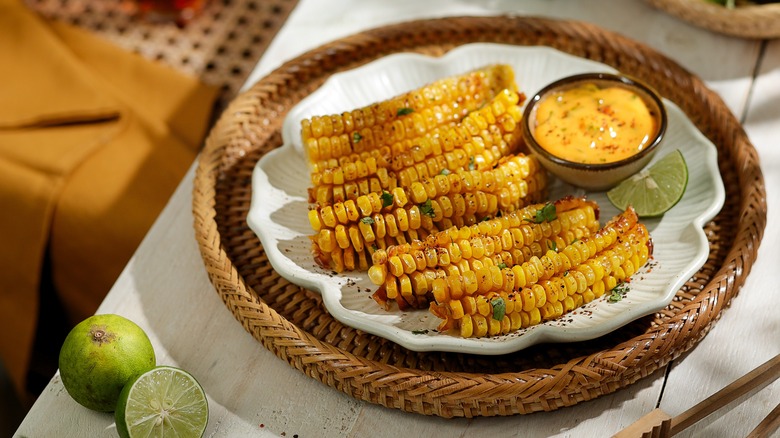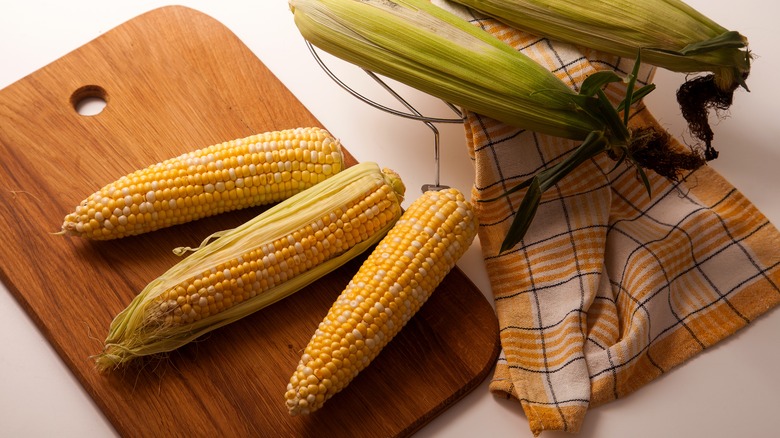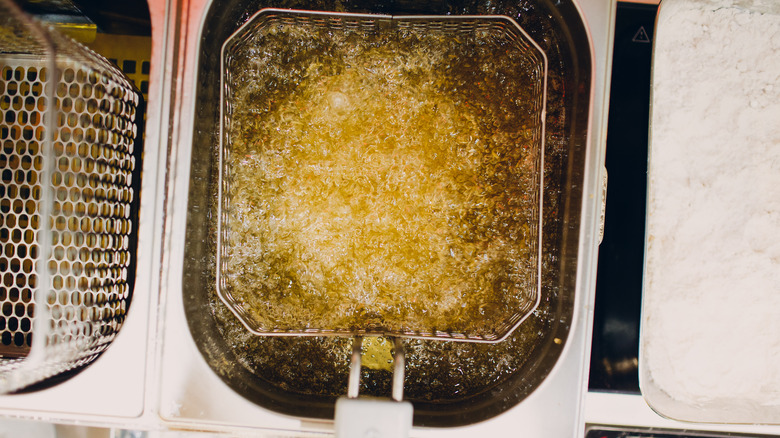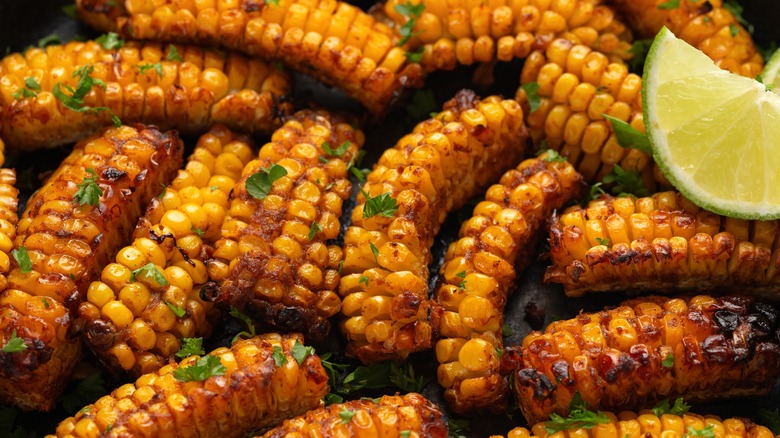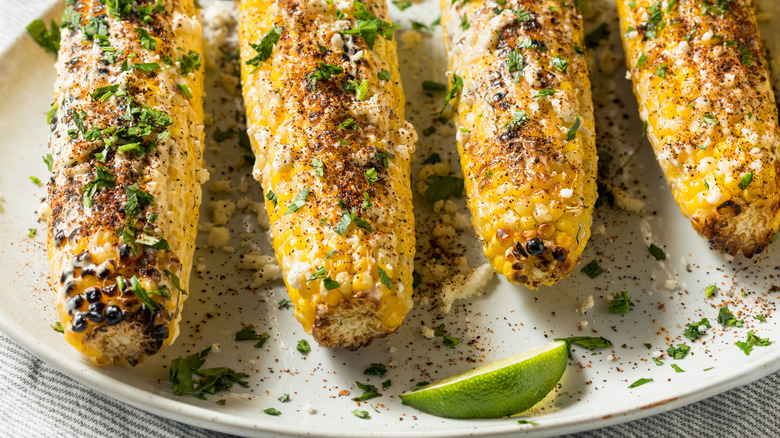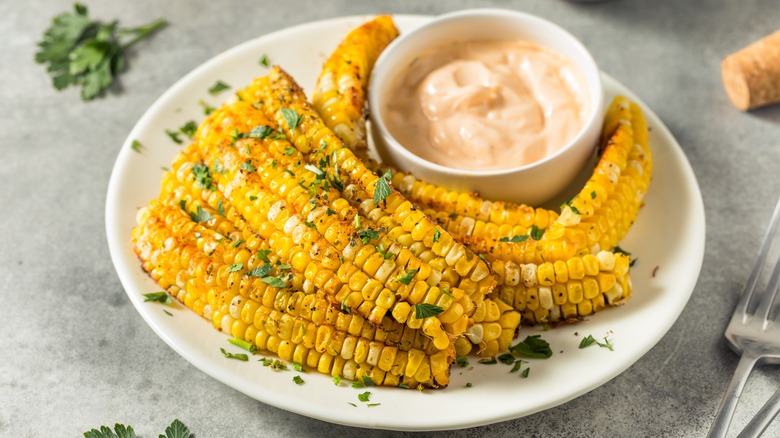The Pro Tips You Need For Great Corn Ribs From A Momofuku Chef
Grilled corn and corn on the cob are must-have sides at any summer barbecue, but did you know you can turn the succulent veggie into a vegan-friendly version of ribs? Named for their rib-like shape and the similar way in which you eat them (albeit off the cob rather than the bone), corn ribs are a mouth-watering dish fit for backyard potlucks, parties, and even casual dinners. At their best, the juicy, caramelized kernels pop in your mouth to release a sweet flavor that contrasts beautifully with savory spice rubs and creamy or tangy sauces. As an added bonus, corn ribs are quick to prepare compared to the standard pork or beef ribs that take hours to slow-roast in the oven.
Whether you want to try making corn ribs for the first time or refine your recipe and technique, professional guidance goes a long way in the kitchen. That's why Chowhound asked Stephan Go, chef at Momofuku Noodle Bar Uptown in New York City, for expert tips on how to cook great corn ribs. This delicious dish first appeared on the menu at the now-closed Momofuku Ssäm Bar in 2017, which claimed credit for its invention on Instagram a few years ago. While you might not strive to replicate Momofuku's fine-dining take on the dish, Go's advice on everything from prep work to seasoning can help you achieve restaurant-quality corn ribs at home.
The strategies for cutting corn ribs like a pro
Corn isn't the easiest produce to work with. While you can speed up prep by efficiently shucking each cob, evenly slicing the corn into rib-like shapes requires some careful and precise knifework. Chef Stephan Go shared a few tips to make easier work of the intact ears of corn once the husks are handled and out of the way, including choosing the right tool for the task and breaking up the ear into smaller pieces as needed.
Since slicing through corn cobs can be hard, Go suggests "using a heavy-duty serrated knife." While you might normally use a sharp chef's knife to cut corn clean off the cob for other recipes, in the case of corn ribs, you should leave the kernels intact and attached to the cob to have something to hold and eat from, as with a rib's bone. Thankfully, the toothed edge of a serrated knife makes quick work of sawing through the tough cob. To trim an ear of corn into ribs, Go advises beginning by cutting both ends of the ear off. If it's still very long, he suggests snapping it in half. He says, "Small manageable pieces will ensure that [you make] more even cuts." This precision is important for even cooking, which results in each relatively uniform corn rib turning out as succulent as the rest.
The best corn ribs are deep-fried
While you can toss a raw rack of ribs on the grill, many people prefer to prepare the cut of meat in the oven where the consistent temperature ensures they cook just right. Take, for instance, this recipe for oven-baked BBQ baby back ribs. Well, it turns out that the grill may not be the optimal way to prepare corn ribs, either. Instead, Chef Stephan Go says that deep frying yields the absolute best corn ribs. Dropping them in bubbling hot oil is a surefire way to make them nice and crispy, while the consistent high heat can help draw out corn's natural sweetness.
To achieve a beautiful golden brown color, Go recommends frying them at a temperature of 350 degrees Fahrenheit. "I think the secret to really good corn ribs is to have a high intense heat for a short period of time," he said. This approach allows for the sugars in the corn to caramelize while the kernels still retain their juicy flavors. In terms of the exact timing, about a minute in the hot oil is all that's needed.
Go says, "You want to cook the corn just enough to be cooked through but not so long that they dry out or get burnt. The high heat caramelizes the natural sugars in the corn while still retaining their juicy flavors." The final product should be a beautifully crisp corn rib that packs a pleasantly sweet flavor with each bite.
Dry rubs are the key to well-seasoned corn ribs
Whether or not you're aiming to whip up corn ribs that compare to BBQ ribs, you'll want to take inspiration from them when it comes to seasoning. However, unlike in the case of pork or beef ribs, Stephan Go suggests doing so once the corn ribs are already cooked. That's because dry rub, his preferred method of seasoning for this veggie version, may not mesh well with hot oil. When applied directly to food that's going into a deep fryer, spices and herbs can end up falling off or burning, contributing little flavor or leaving behind unpleasant ones. Instead, Go uses dry rubs to season corn ribs after they come out of the fryer.
Additionally, while every passionate pit master and backyard griller is bound to have a go-to dry rub recipe, the usual mix of spices and herbs for steak or chicken breast might not be best suited to corn. Go suggests something that might seem a little unorthodox: savory popcorn seasoning. If you don't have one handy, he mentions that you can make your own.
His pro tips for creating the seasoning? "I would advise adding a bit more salt to offset the sweetness of the corn as well as omitting sugar to your seasonings," he says. Although sugar is commonly added to dry rubs, when it comes to corn ribs, prioritizing savory spices can lend them a more balanced flavor since the sugar's already built-in.
Experiment with sauces and toppings
Besides seasoning, part of the beauty of corn ribs is the room they give you to play around with flavor by coming up with creative sauces and toppings. For instance, Momofuku serves them in a pile on top of squid ink aioli and whipped ricotta, a reflection of the restaurant's approach to contemporary Asian-American cuisine. But Chef Stephan Go says there are plenty of other options worth trying with corn ribs. "The possibilities are endless," he emphasized. "Explore different recipes and flavor combinations that go well with corn and experiment."
When it comes to selecting sauces and toppings, Go recommends drawing inspiration from other corn dishes. He mentioned one standout example in particular: elote. The staple of Mexican street food usually features mayo or crema, fresh lime, chile powder, hot sauce, and crumbly cotija cheese. The elements of salt, fat, acidity, and heat work wonderfully when combined with the crispy corn ribs' natural sweetness. While Momofuku opts for smooth ricotta, Go says, "The addition of cheese to the corn ribs adds another dimension to the dish."
To get finicky toppings like chopped cilantro to stick, he suggests tossing the ribs in some melted butter first, which also lends extra richness. However, if you're not a huge fan of how messy ribs can get, you can incorporate the flavors in a warm elote dip or opt for a similarly creamy avocado dip instead.
How to prep corn ribs ahead of time
While corn ribs might be faster to make than regular ribs, quite a bit of work still goes into preparing the veggie version. That said, it's possible to do some of the prep in advance, a strategy employed by plenty of professional chefs. This can be helpful if you're planning to cook corn ribs for a party or potluck but won't have a ton of time to do everything on the day of.
Of course, the pain-staking steps of shucking and removing the stringy corn silk are worth working on ahead of time, but there are a few other parts of the process you can take care of. Stephan Go suggests prepping the corn ribs in advance by cutting and storing them in a sealed container about a day or two before cooking them. The same goes for any seasonings or sauces. The only step you shouldn't tackle early is the frying. According to him, "Corn ribs are best enjoyed immediately after they are cooked." Fortunately, though, they only need a minute in the hot oil, so all the time-consuming parts of prep can be finished beforehand.
Armed with expert advice, chances are that you and any potential dinner guests will devour all the delicious homemade corn ribs on the table. However, if there are any leftovers, Go recommends tossing them into other dishes like salads, fried rice, or stir-fries for an extra burst of flavor.
